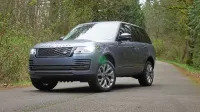2020 Range Rover P400e Review | Plugged in and better for it

No, it most certainly does not.
“OK, so how does 32 mpg sound instead?”
That’s what I could reply after driving the Range Rover P400e plug-in hybrid for 75 miles of mixed city, mountain and rural highway driving after charging its battery overnight. Like other plug-in hybrids, that number could be much higher should you keep closer to its estimated 31 miles of electric range (official EPA estimates are expected to be a bit lower). One day I drove 41.1 miles and observed 43.7 mpg. On the other hand, if you go on an extended drive beyond that electric range, it seems reasonable to expect something in the mid-20-mpg range (EPA-estimated fuel economy also hasn’t been released).



Now, can such fuel economy be considered truly green? No way. Does the multitude of extra resources devoted to producing a Range Rover compared to a Kia Niro PHEV, for instance, chip away some of whatever extra greenness you get with the plug-in hybrid version? Probably.
Yet, here’s a dose of reality: If you’ve got $108,945 to spend, you’re probably not in the market for a Niro. If you’re going to buy a Range Rover anyway, why not get the plug-in hybrid one that gets 32 mpg instead of the 19-mpg supercharged V6 or 18-mpg supercharged V8?
“Gobs and gobs of delicious power,” you might answer. True, the hybrid is slower to 60 mph (6.4 seconds) than the supercharged V8 (5.1 seconds), but it’s quicker than the base supercharged V6’s 7.1 second run. And perhaps there’s a stigma attached to the knowledge you’re driving a Range Rover with a four-cylinder engine, but that should be tempered by the total system output: 398 horsepower and 472 pound-feet of torque.
Electric power is also quite in keeping with the Range Rover norm of torque-rich, effortless and quiet acceleration. The Range Rover full-stop isn’t some high-powered barking beast like a Range Rover Sport SVR. It’s about grand, stately civility. Silently wafting along without an engine running only adds to that.
When the grid-sourced electricity is exhausted or max power is needed, that 2.0-liter turbocharged four-cylinder does come to life and sounds nothing like a blown V8. It’s different, but not objectionable — certainly no more so than the optional diesel engine. That, by the way, goes from zero to 60 mph in 7.5 seconds and returns an EPA-estimated 24 mpg combined (2018 figures). It also burns filthy diesel fuel.


On the other hand, that the Range Rover PHEV burns any fuel at all is certainly noteworthy to those who will note there is a high-dollar luxury SUV available that is purely electric: the Tesla Model X. Its Performance model starts at virtually same price as the P400e, goes 305 miles on a charge and hits zero to 60 mph in 3.4 seconds — and that’s without the $20,000 Ludicrous Mode option. On paper, there is certainly no disputing the superiority of Tesla’s 100-large luxury SUV in terms of greenness and performance.
However, I’ve driven a Model X and it’s no Range Rover. Not even remotely close. I could end my argument with “exponentially superior cabin quality” alone, but there’s the ride quality, the seat comfort, the more functional body style, the lack of goofy doors that break, and the fact that Jaguar-Land Rover isn’t treating you as a beta-testing guinea pig. True, Land Rover’s dual-screen infotainment system takes a block-and-a-half after starting to respond to everything from a radio station change to heated seat activation, but that jumbo touchscreen in the Model X isn’t exactly a paragon of reliability. Neither is either overall vehicle, to be honest, far from it, so that’s at least a wash.
All of this isn’t to decry the Model X — well, mostly. It’s just to explain why someone might value a Range Rover despite on-paper arguments involving 0-60 times and electric range. Perhaps they won’t be cross shopped at all, but their common price, prestige and greenness (admittedly to differing degrees) certainly makes them seem like common choices for those in Beverly Hills, Palo Alto, Nassau County and anywhere where green consciousness and excessive greenbacks converge. And if I were in that position, I know which of the two I’d pick: the P400e, thank you.
Of course, if there was something stately-yet-macho with a classy, well-built cabin that could also go 300 miles on a charge and hit 60 mph in less than 4 seconds, well then, that would just be peachy. If only someone was working on such a thing …




